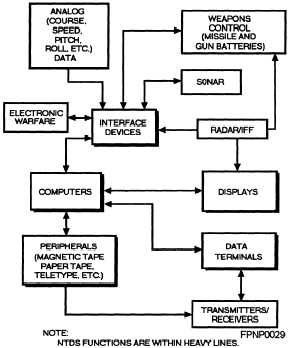l Keyboard —Keyboards are input devices used to
control operation of a computer.
. Printer —Printers are output devices for
producing printed material.
. Modem —Modems are optional components
used to communicate with mainframes, minicomputers,
and microcomputers through existing phone lines.
l Mouse —Another optional component is a
mouse. A mouse is an input device used to highlight
text, move the cursor, and select commands and
functions without using the keyboard. A mouse can be
used in combination with a keyboard to control
computer operations.
TOPIC 2—FUNCTIONAL OPERATION
OF COMPUTERS
At the heart of every data system is a computer. All
digital data made available on any system has been
processed by the computer. The computer oversees the
operation of any data system. Through a coordinated
series of interrupts, requests, and acknowledges, the
computer exchanges data with other computers,
peripherals, and the subsystems required for that
system.
The signal flow between systems, subsystems, and
equipment
is all coordinated by the operational
program of the computer(s). Exchange of signals
between the systems, subsystems, and equipment is
accomplished through a coordinated series of priorities
where interrupts, requests, and acknowledges
determine when the data will be exchanged. The type
of data exchanged includes status signals, control
signals, and data words. Interfacing between the
computer(s) and other systems, subsystems, and
equipment requires some type of cabling-standard
shielded and unshielded cables, fiber-optic cables, and
ribbon cables, and their associated connectors.
Methods of interfacing include parallel and serial data
transfers.
OPERATIONAL USES OF COMPUTERS
You may have the opportunity of maintaining three
basic types of data systems: tactical, tactical support,
and nontactical.
All three rely on one or more
computers to make rapid calculations and make
information available.
Tactical Systems
A computer is the heart of the Combat Direction
System (CDS)/Naval Tactical Data System (NTDS),
which is a subsystem of the ship’s combat system.
CDS/NTDS receives data from ship’s sensors and other
ships using tactical data links. The CDS/NTDS consists
of high-speed digital computers, peripherals, displays,
communication links, and computer programs. The
CDS/NTDS hardware is divided into three major
equipment groups (subsystems) as follows:
l Data Processing Group
l Data Display Group
l Data Communications Group
The data these subsystems generate and feed back
to the data processing subsystem is stored, processed,
and distributed by the operational program. The
computer is part of the data processing group and
coordinates the operations within CDS/NTDS and
makes the information available to other major
subsystems within combat systems: radar/IFF, weapons
(guns, missiles, and underwater), electronic warfare,
and navigation. The CDS/NTDS is a real-time system.
The type of computer used in a tactical data system is a
mainframe such as the AN/UYK-7(V) or
AN/UYK-43(V) computer. The number of computers
used in a tactical data system depends on the class of
ship and its configuration/setup. Figure 1-6 is a portion
Figure 1-6.—Simplified block diagram of a tactical data
system (CDS/NTDS).
1-7


